
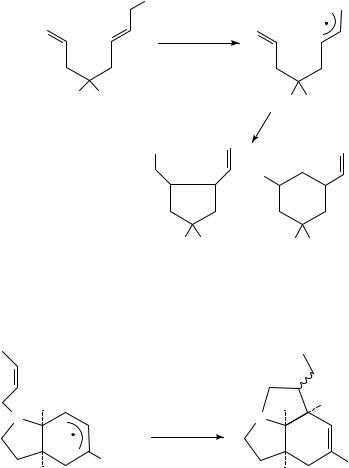
13. Radical addition to polyenes
cyclization was observed in the absence of ester groups.
I
hν, (Bu3Sn)2
C6 H6 , 50˚C
E E E E
E = CO2 CH3
I
|
I |
|
+ |
E E |
E E |
50% |
2% |
629
(6)
Cyclization has also been observed for those cases in which allyl radicals are stabilized by additional substituents. Radicals 9, which carry an ester group at one allyl terminus, cyclize readily in a 5-exo fashion to furnish products 10 in good yield. No 6-exo product was found in this instance (equation 7)45.
H |
H |
H |
N |
N |
|
|
HSnBu3 |
(7) |
|
C6 H6 |
|
|
|
|
CO2 CH3 |
R |
CO2 CH3 |
R |
|
|
(9) |
(10) |
|
R = Ph, SPh |
60 − 85% |
|
Finally, allyl radicals have successfully been employed in macrocyclization reactions, in which the slower rate of reaction of allyl radicals with hydrogen donors turned out to be advantageous46. Thus, radical 11 cyclizes in 14-endo mode to provide, after trapping with tin hydrogen, the product 12 as a E/Z-mixture of the C2/C3 double bond. No products derived from 6-exo or 10-exo cyclizations could be found (equation 8). This can be rationalized by assuming a faster rate of addition of the nucleophilic allyl radical to the electron-deficient terminal double bond than to the C6 or C10 double bonds.
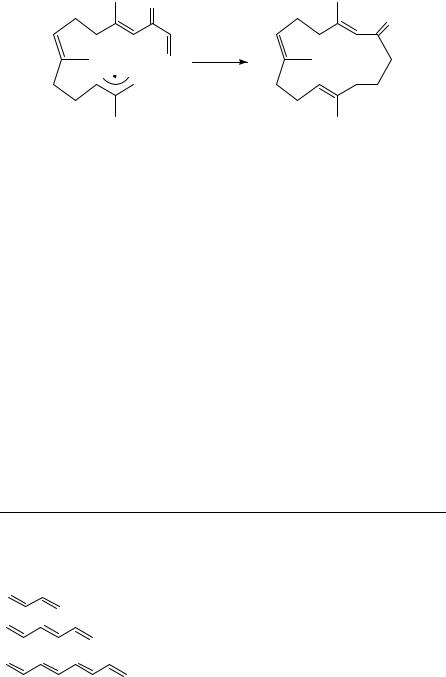
630 |
H. Zipse |
O
O
C6 H6
(8)
HSnBu3
(11) |
(12) |
52% |
In conclusion, it appears that allyl or polyenyl radicals are much less reactive than alkyl radicals, which restricts the use of polyenes in intermolecular radical chain reactions to simple two-step processes. Allyl radicals are, however, reactive enough to partake in a variety of intramolecular reactions.
IV. REGIOSELECTIVITY OF RADICAL ADDITION REACTIONS TO POLYENES
The regioselectivity in radical addition reactions to alkenes in general has successfully been interpreted by a combination of steric and electronic effects18b,47. In the absence of steric effects, regiochemical preferences can readily be explained with FMO theory. The most relevant polyene orbital for the addition of nucleophilic radicals to polyenes will be the LUMO; for the addition of electrophilic orbitals it will be the HOMO. Table 10 lists the HOMO and LUMO coefficients (without the phase sign) for the first three members of the polyene family together with those for ethylene as calculated from Huckel¨ theory and with the AM1 semiempirical method48.
The orbital coefficients obtained from Huckel¨ calculations predict the terminal position to be the most reactive one, while the AM1 model predicts the C1 and C3 positions to be competitive. In polyenes, this is true for the addition of nucleophilic as well as electrophilic radicals, as HOMO and LUMO coefficients are basically identical. Both theoretical methods agree, however, in predicting the C1 position to be considerably more reactive as compared to the C2 position. It must be remembered in this context that FMO-based reactivity predictions are only relevant in kinetically controlled reactions. Under thermodynamic control, the most stable adduct will be formed which, for the case of polyenyl radicals, will most likely be the radical obtained by addition to the C1 position.
TABLE 10. HOMO and LUMO coefficients for ethylene and selected polyenes
Alkene |
|
|
|
|
HMO |
|
|
|
AM1 |
|
||||
|
|
|
|
|
|
C1 |
C2 |
C3 |
C4 |
|
C1 |
C2 |
C3 |
C4 |
|
|
|
|
|
|
|
|
|
|
|
|
|
||
|
|
|
|
LUMO |
0.71 |
|
|
|
0.71 |
|
|
|
||
|
|
|
|
|
|
|
|
|
|
|||||
1 |
|
|
HOMO |
0.71 |
|
|
|
0.71 |
|
|
|
|||
2 |
|
LUMO |
0.60 |
0.37 |
|
|
0.56 |
0.43 |
|
|
||||
1 |
|
|
HOMO |
0.60 |
0.37 |
|
|
0.56 |
0.43 |
|
|
|||
|
|
|
|
|
|
|
|
|
|
|
|
|
||
2 |
|
LUMO |
0.52 |
0.23 |
0.42 |
|
0.45 |
0.28 |
0.47 |
|
||||
1 |
|
3 |
HOMO |
0.52 |
0.23 |
0.42 |
|
0.44 |
0.29 |
0.47 |
|
|||
|
|
|
|
|
|
|
|
|
|
|
|
|||
2 |
4 |
LUMO |
0.46 |
0.16 |
0.41 |
0.30 |
0.36 |
0.20 |
0.44 |
0.37 |
||||
1 |
|
3 |
HOMO |
0.46 |
0.16 |
0.41 |
0.30 |
0.36 |
0.21 |
0.43 |
0.37 |
|||
|
|
|
|
|
|
|
|
|
|
|
|
|||
|
|
|
|
|
|
|
|
|
|
|
|
|
|
|
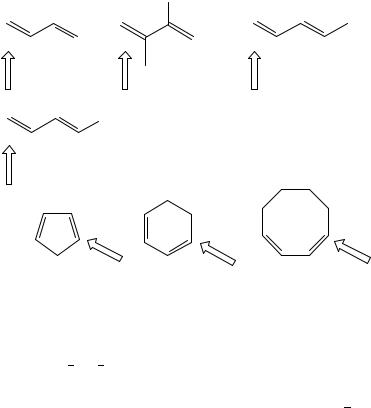
13. Radical addition to polyenes |
631 |
Most of the dienes investigated experimentally show high regioselectivity in radical addition reactions. The preferred position of attack is shown in Scheme 2.
2 |
2 |
2 |
4 |
1 |
1 |
1 |
3 |
2 |
4 Ph |
1 3
SCHEME 2
In one of the earliest investigations of regioselectivity in radical addition reactions to polyenes, the addition of hydrogen bromide to 1,3-butadiene was observed to yield mainly the 1,4-addition product in the presence of peroxides40. The preference for attack at the C1 position of 1,3-butadiene has subsequently been observed for a large number of radicals3,14,17,30,34,37 39,49 56. Only for the addition of the methyl radical has the ratio of addition to the C1 vs C2 actually been measured. A value of C1:C2 D 1.0:0.01 has been found50. For all other cases, products arising from attack at C2 have not been reported. This is also true for radical addition to 2,3-dimethyl-1,3-butadiene9,10,32,34,37 39,57. Additions to 1,3-pentadiene occur predominantly at the C1 position due to the steric effect exerted by the terminal methyl group10,33,34,37,51,58. This is a reflection of the reduced addition rate to C4 due to the steric effects of ˛-substituents18b. Rate retardation does not, however, go as far as redirecting addition to the C2/C3 centers, as ESR investigation of the propagating radical chain in the polymerization of 2,4-hexadiene has shown14. The early observation of exclusive C4-addition in the reaction of thiophenol with 1-phenyl-1,3- butadiene can also be explained by steric effects59. The hydrostannation of cyclic olefins proceeds with exclusive attack of the intermediate stannyl radicals on the terminal diene positions37,38. Addition of malonyl or tosyl radicals to cyclopentadiene and cyclohexadiene also takes place at the C1 position10,32,57,60. Isoprene represents an interesting case in that the two terminal positions are nonidentical due to their ˇ-substituents. Again, no additions to the non-terminal carbon centers have been reported, but the C1:C4 addition ratio strongly depends on the attacking radical (Table 11). The selectivity pattern in the addition of thiols to chloroprene is almost identical to that observed for isoprene33,34. A somewhat more complex situation exists in the radical chain addition of CCl4 to cembrene 1361. Attack of the trichloromethyl radical occurs exclusively at the C5 center of 13 to form adduct radical 14 (equation 9). The high regioand stereoselectivity appears
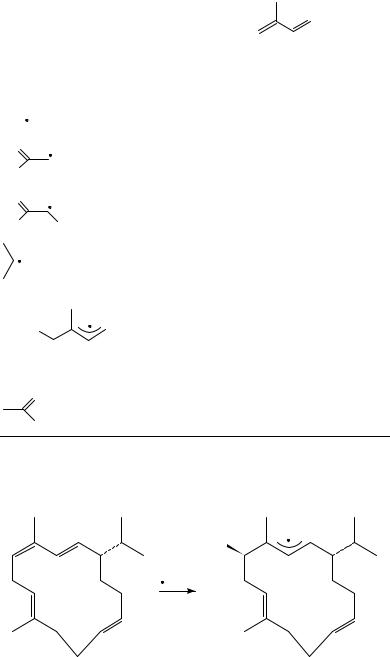
632 |
|
|
|
|
H. Zipse |
|
|
|
|
TABLE 11. Regioselectivity in the radical addition to isoprene |
|
|
|||||
|
|
|
|
|
|
|
|
|
|
Radical |
T °C |
Solvent |
|
|
Reference |
||
|
|
|
|
|
|
1 |
3 |
|
|
|
|
|
|
|
2 |
4 |
|
|
|
|
|
|
|
C1 :C2 :C3 :C4 |
|
|
|
Cl3Cž |
80 |
CCl4 |
C4 only |
|
51 |
||
|
O |
20 |
C6H6 |
C1 only |
|
13 |
||
|
|
|
|
|
||||
|
Ph2 P |
|
||||||
|
|
|
|
|
|
|||
|
O |
|
|
|
|
|
||
|
|
|
|
25 |
HOAc |
1.0:0.0:0.0:2.8 |
53 |
|
|
HO |
|
|
|
|
|
||
|
O |
|
|
|
|
|
||
|
|
|
|
25 |
HOAc |
1.0:0.0:0.0:7.8 |
53 |
|
|
HO |
CN |
|
|
|
|
||
|
|
|
|
0 |
CH3OH |
3.4:0.0:0.0:1.0 |
54b |
|
|
Me3Snž |
100 |
Me3SnH |
1.0:0.0:0.0:1.0 |
38 |
|||
|
Polymer |
20 |
Isoprene |
C1 only |
|
14 |
||
|
|
|
|
|
|
|||
|
CH3Sž |
25 |
neat |
3.5:0.0:0.0:1.0 |
33,34 |
|||
|
PhSž |
25 |
neat |
39:0.0:0.0:1.0 |
33,34 |
|||
|
|
|
O |
|
|
|
|
|
|
|
|
|
25 |
neat |
8.9:0.0:0.0:1.0 |
33,34 |
|
S
to be the consequence of steric effects as the X-ray structure of 13 shows the C2 position blocked by the isopropyl group from the top side, and by the ring C14 center from the bottom side, while addition can occur unhindered from the top side at C5.
|
3 |
1 |
|
Cl3 C |
|
1 |
5 |
4 |
2 |
|
5 |
4 |
2 |
|
|
|
|
6 |
|
3 |
|
6 |
14 |
CCl3 |
|
14 |
|
|
|
|
|
|
||
|
|
|
|
|
|
(9) |
(13) |
(14) |

13. Radical addition to polyenes |
633 |
The regioselectivity in diene addition reactions can also be influenced by ring strain effects in cyclization reactions. The regioselectivity is highly predictable in those cases, in which addition to the preferred diene center forms the preferred ring size. Thus, the cyclization of radical 15 proceeds readily to form the cis-disubstituted cyclopentylmethyl radical 16 with high selectivity39. Similarly, cyclization of 17 affords exclusively bicyclic radical 18, in which the additional cyclopentane ring has been formed by addition to the terminal position of the butadiene subunit62. This preference for 5-exo cyclizations onto dienes is not even disrupted by substituents at the C1 or C4 positions of the diene system, as seen for radical 19, which cyclizes to 20 (equation 10)63. This is in contrast to alkyl radical cyclizations to alkenes, in which major amounts of 6-endo cyclization is observed for 5-substituted systems43.
CO2 CH3 |
CO2 CH3 |
|
Cl |
|
Cl |
|
|
|
|
(15) |
|
(16) |
|
O |
C5H11 |
O |
C5H11 |
|
|
|
|
O |
|
O |
(10) |
|
|
||
|
CO2 CH3 |
|
CO2 CH3 |
|
|
|
|
(17) |
|
|
(18) |
(19) |
(20) |
An interesting example of the situation in which the preferred addition site does not lead to the preferred ring size has been provided by Miura and coworkers with the extended vinylcyclopropane rearrangement of substrate 2164. Formation of vinylcyclopentyl derivative 22 requires the addition of the triphenylstannyl radical to the unsubstituted terminus
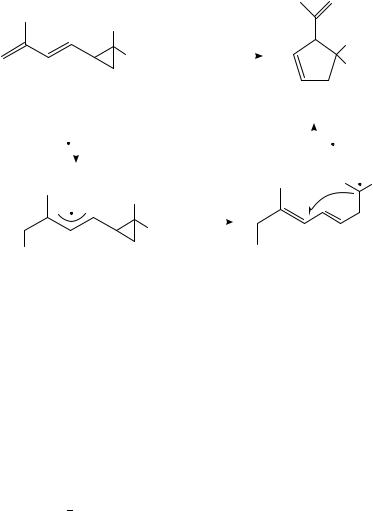
634 |
H. Zipse |
of the diene moiety in 21 to form intermediate allyl radical 23. Cyclopropane ring opening then gives acyclic radical 24, which cyclizes in a 5-exo-trig fashion to yield, after elimination of triphenylstannyl radical, product 22 (equation 11). The attack at the C2 center of the diene system in the cyclization step is the only known example in which addition to the central carbon atoms of the diene unit occurs readily. In this particular case, the unusual regiochemistry is caused by the favorable cyclization geometry as well as by the presence of the triphenylstannyl leaving group in the -position.
CO2 Me
|
|
|
Ph3 SnH, A IBN |
CO2 Me |
|||||
|
|
CO2 Me |
|
|
|||||
|
|
|
|
|
|
|
|
|
|
|
|
|
C6 H6 |
CO2 Me |
|||||
|
|
|
|
||||||
|
|
|
|
|
|
|
|
||
(21) |
(22) |
74% |
|
||||||
|
|
|
|
|
|
|
|
(11) |
|
+ Ph3 Sn |
|
|
|
|
|
|
− |
SnPh3 |
|
|
|
|
|
|
|
||||
|
|
|
|
|
|
|
|
|
|
|
|
|
|
|
|
MeO2 C |
CO2 Me |
||
|
|
|
|
|
|
||||
|
|
CO2 Me |
|
|
|||||
|
|
|
|
|
|
|
|
||
|
|
CO2 Me |
|
|
|||||
Ph3 Sn |
|
|
Ph3 Sn |
|
|
||||
(23) |
(24) |
|
|||||||
In conclusion, the regiochemistry of radical attack at dienes appears to be rather predictable by considering steric and electronic effects. Attack is almost always preferred at the terminal carbon atoms of the diene. ˛-Substituents retard the addition significantly in all known cases while the steric effects of ˇ-substituents depend on the nature of the attacking radical.
V.REGIOSELECTIVITY IN REACTIONS OF POLYENYL RADICALS A. Trapping with Closed-shell Molecules
Allyl radicals substituted at only one of the terminal carbon centers usually react predominantly at the unsubstituted terminus in reactions with nonradicals. This has been shown in reactions of simple dienes such as butadiene, which react with hydrogen bromide, tetrachloromethane or bromotrichloromethane to yield overall 1,4-addition products35,58. The reaction of allyl radicals with hydrogen donors such as thiols33,34,36a or tin hydrides37 39 has been investigated and reviewed repeatedly. In most cases, the thermodynamically more favorable product is formed predominantly. This accords with formation of either the higher substituted alkene or the formation of conjugated - systems. Not in all cases, however, is the formation of the thermodynamically more favorable product identical to overall 1,4-addition to the diene. In those cases in which allyl radicals are formed through reaction of dienes with tin hydrides or thiols, the
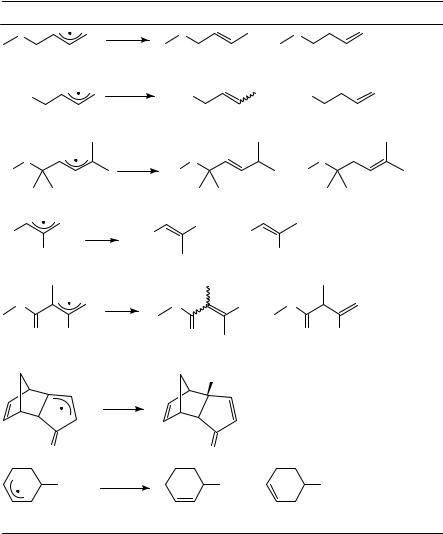
|
|
|
13. Radical addition to polyenes |
|
635 |
|||
TABLE 12. Examples for the trapping of allyl radicals with thiols and tin hydrides |
|
|||||||
|
|
|
|
|
|
|
|
Reference |
S |
|
CH3 SH |
|
S |
+ |
S |
|
33 |
|
|
|
|
<95% |
|
|
<5% |
|
Me3 Sn |
|
Me3 SnH |
Me3 Sn |
+ |
Me3 Sn |
|
38 |
|
|
100°C |
|
|
|||||
|
|
|
|
|
|
|
|
|
|
|
|
|
93% |
|
|
7% |
|
S |
|
CH3 SH |
S |
|
+ Ph |
S |
33 |
|
Ph |
|
|
|
Ph |
|
|
|
|
|
|
|
|
23% |
|
|
77% |
|
Ph |
|
PhSH |
Ph |
SPh |
Ph |
|
|
|
|
+ |
|
|
36a |
||||
|
|
|
|
|
|
|
||
|
SPh |
|
|
|
|
SPh |
|
|
|
|
|
50% |
|
50% |
|
|
|
O |
|
PhSH |
|
O |
SPh + |
O |
|
|
|
8 0 °C |
|
|
36b |
||||
|
|
|
|
|
|
|
||
O |
SPh |
|
|
|
|
O |
SPh |
|
|
|
O |
|
|
||||
|
|
|
|
98% |
|
|
2% |
|
|
|
|
|
H |
|
|
|
|
|
|
t-BuSH |
|
|
only |
|
|
36c |
|
|
|
|
|
|
|
|
|
|
O |
|
|
O |
|
|
|
|
|
SnMe3 |
Me3SnH |
|
SnMe3 |
|
SnMe3 |
38 |
|
|
|
|
|
|||||
|
|
|
|
66% |
|
34% |
|
|
reaction with thiols appears to proceed with slightly higher regioselectivity. The rule of predominant formation of the thermodynamically more favorable product also pertains to the E:Z selectivity of the product alkenes36. Table 12 gives some representative examples.
The few cases in which thermodynamic control is not effective appear to be dominated by steric effects39. Thus, trapping of radical 25 with triphenyltin hydride regioselectively yields product 26, in which the double bond is separated from the ester through a methylene bridge (equation 12).
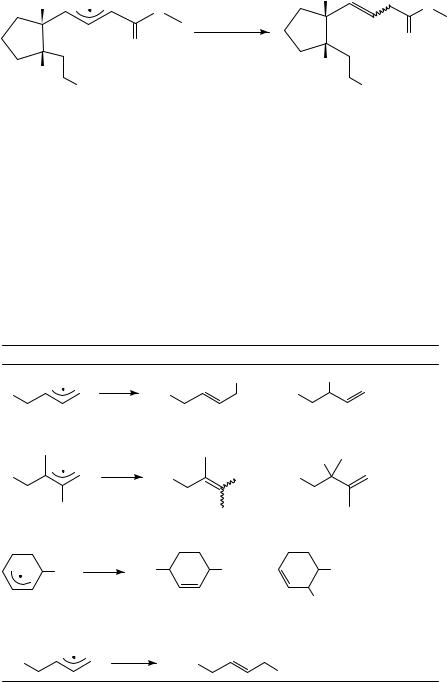
636 |
|
H. Zipse |
H |
|
H |
O |
O |
|
|
|
O
H
Ph3 SnH
C6 H6 , 80 °C
O
(12)
H
Cl |
Cl |
|
(25) |
(26) |
60% |
Allyl radicals are also formed during the radical halogenation of dienes65,66. The regioselectivities obtained in these reactions depend markedly on the reaction conditions, because formation of the reaction products is also possible through polar reaction pathways. In those cases in which proper care has been taken to ensure a radical mechanism, the halogenation of dienes proceeds with much lower regioselectivity in the halogen transfer step as compared to the hydrogen transfer reactions considered before (Table 13). The reagent used to deliver the halogen, in contrast, appears to have only a small influence. Many results for the trapping of allyl radicals with bromine exist from the allylic halogenation with N-bromosuccinimide. The regioselectivity of this reaction has been reviewed67.
The addition of tosyl cyanide to cyclopentadiene leads to intermediate formation of radical 27, which then is trapped by tosyl cyanide by cyano group transfer. The trans-
TABLE 13. Examples for the trapping of allyl radicals with halogen donors
|
|
|
|
|
|
|
Reference |
|
Cl2 |
|
|
Cl |
|
|
Cl |
Cl |
|
Cl |
|
+ |
Cl |
65 |
|
−9 °C |
|
|
|||||
|
|
|
|
|
|
|
|
|
|
|
|
78% |
|
|
22% |
|
PhICl2 |
|
|
|
|
|
Cl |
Cl |
|
Cl |
Cl |
+ |
Cl |
66 |
|
|
|
|
|||||
|
|
|
|
52% |
|
|
48% |
Cl |
PhICl2 |
Cl |
|
Cl |
+ |
|
Cl |
|
|
|
|||||
|
|
|
|
|
|
|
66 |
|
|
|
|
|
|
|
Cl |
|
|
|
|
50% |
|
50% |
|
|
|
|
|
|
|
|
|
Cl3 C |
BrCCl3 |
|
Cl3 C |
|
|
30, 31, 35 |
|
|
|
|
|
Br |
|||
|
|
|
|
|
|
|
|
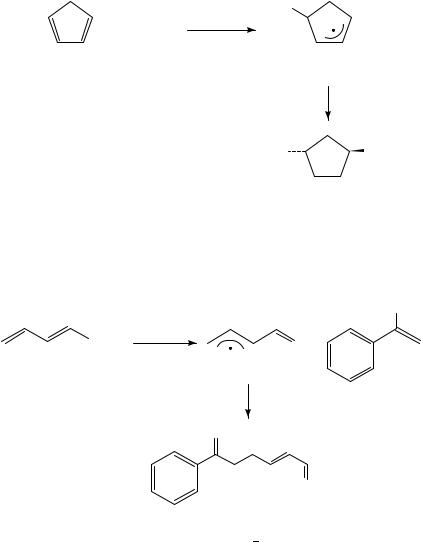
13. Radical addition to polyenes |
637 |
1,4-addition product is formed exclusively (equation 13).
Tos
N2
+ Tos−CN
C6H6 , 60 ° C
(27)
Tos−CN |
(13) |
|
Tos |
CN |
68%
Only a few examples exist for the intermolecular trapping of allyl radicals with alkenes68,69. The reaction of ˛-carbonyl allyl radical 28 with silyl enol ether 29 occurs exclusively at the less substituted allylic terminus to form, after oxidation with ceric ammonium nitrate (CAN) and desilylation of the adduct radical, product 30 (equation 14). Formation of terminal addition products with trans-configuration has been observed for reaction of 28 with other enol ethers as well.
OSiMe3
OSiMe3 |
CAN |
O |
|
|
CH3CN, 0˚C |
(28)
(29)
(14)
O
O
(30) 69%
Intramolecular trapping of allyl radicals by carbon carbon double bonds has, of course, been observed to occur readily and with high selectivity (see Sections III and IV).
B. Trapping with Radicals
The trapping of allyl radicals with other open-shell species can be studied in all reactions in which a sufficiently high concentration of radicals is created and in which the concentration of nonradical trapping agents is low. This prerequisite has been met in Kolbe electrolysis reactions, in which radicals are generated by one-electron oxidation of carboxylate anions. One of the simplest systems, the reaction of methyl radicals with

638 |
H. Zipse |
butadiene, has been studied in this way52. Methyl radicals are obtained by oxidation of acetate anions and subsequent decarboxylation of the resulting acetyloxy radicals. Addition to butadiene then leads to the adduct allyl radical 31, which is trapped by a second methyl radical to form the overall 1,4-addition product trans-3-hexene exclusively (equation 15).
CH3 CO2 −  CH3 CO2
CH3 CO2  CH3
CH3
(15)
CH3
(31)
Allyl radicals can, of course, also be generated by electrolysis of the corresponding ˇ, -unsaturated carboxylic acids together with a second carboxylic acid. This ‘mixed Kolbe electrolysis’ method has been used to study the recombination of allyl radical 32 with the undecyl radical 3370. Recombination leads to the formation of adducts 34 and 35 in a ratio of 72:28, again preferring the product with the higher substituted double bond (equation 16).
C10 H21 |
+ |
|
|
|
|
C10 H21 |
|
(34) |
|
(35) |
|
92% |
|
8% |
|
O |
|
O |
Kolbe-electrolysis |
|
+ |
C10 H2 1 |
CH3OH/NaOH |
OH |
HO |
−20 ˚C |
|
|
|
|
+ C10 H2 1 |
|
|
(32) |
(33) |
72% |
|
28% |
|
(16)
−78°C hν
O
|
O |
O |
C10 H21 |
O
(36)
